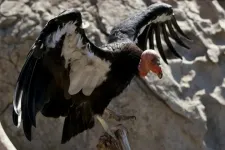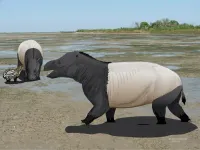(Press-News.org) The once-abundant California condor briefly went extinct in the wild, with only 22 individuals living in captivity by 1982. Today, 300 condors live freely in the wild and another 200 are in captivity. But, despite the condor's struggles, a new study of the California condor genome reported in the journal Current Biology on May 13 has found a surprising amount of genetic diversity.
The study is the first to begin quantifying diversity across the entire California condor genome, which offers researchers needed baseline information to inform future research and conservation of this iconic species, the largest species of land bird in North America. The researchers say that the quality of their genome assembly is among the highest for any bird genome sequenced to date.
"We estimated that prior to 10,000 years ago, there were tens of thousands of condors," says Jacqueline Robinson of the University of California, San Francisco. "The relatively high level of diversity in condors today is a legacy of their high historical population sizes."
She adds, "Our results accord with what we know from the fossil record, which is that the ancestors of California condors once ranged across the contiguous United States. Over time, the condor's range shrank until they only persisted along the Pacific coast, where they were able to incorporate the carcasses of large marine mammals into their diet."
The condor nearly went extinct in the 20th century from lead poisoning, poaching, and loss of habitat. But much about the bird's history remains obscure. To fill this gap and aid future management of the species in the new study, the researchers, including Robinson and Jeff Wall, also of UCSF, along with Cynthia Steiner of San Diego Zoo Wildlife Alliance, produced a high-quality chromosome-length genome assembly for the California condor. They also analyzed its genome-wide diversity.
For comparison, the team examined the genomes of two close relatives of the California condor: the Andean condor and the turkey vulture. They report that the genomes of all three species show evidence of historic population declines. However, the California condor genome shows a surprisingly high degree of variation from its historical abundance.
"Our study showed that the California condor's history includes a long-term decline over geologic time that predates its recent near extinction driven by human activity," Robinson said. "This isn't to say that the California condor was already doomed to extinction, because we found historical declines in the Andean condor and turkey vulture as well, and turkey vultures are extremely abundant today. The consistent pattern of historical decline in these species may be connected with the decline and extinction of avian scavenger species in the Americas since the Pleistocene, but we need to do more research to really address this question."
Long-term evolutionary forces and recent inbreeding have shaped the California condor genome, according to their analysis. Nevertheless, outside of regions where California condors lacked variability due to inbreeding, they found relatively high genetic diversity. The researchers also found encouraging evidence that purifying selection had removed deleterious mutations from the population, which they say bodes well for future restoration of the species.
"Despite the severe bottleneck the California condor experienced in the 20th century, the genome retains a relatively high degree of genetic variation that is representative of the ancestral demographic history of the species, with a larger ancestral population size," Steiner said. "This is an extraordinary finding, observed in few other critically endangered species such as the vaquita," she says, referring to a species of porpoise that is the most endangered marine mammal. "It's very promising in terms of the recovery potential of this species in the wild if current threats are managed."
"We didn't know to what extent California condor genomes would show signs of inbreeding," Robinson added. "We now know that there was some inbreeding in the wild prior to the start of captive breeding efforts. Future sequencing of more individuals will tell us if there are regions of the genome that have completely lost variability, or if captive breeding and building up the population size over the past few decades has mitigated the effects of previous inbreeding."
Steiner says they plan to extend the genomic research on California condors at the population level to better understand levels of inbreeding and genetic erosion and to measure genetic load in the living population. An important goal is to determine the genetic basis of fitness-related traits and disease. For example, they now have the genomic tools needed to understand the genetic basis of traits such as chondrodystrophy (abnormal skeletal growth) and the fourteen-tail feather syndrome (in which condors have two extra tail feathers) and potentially manage these deleterious traits in the breeding program, she says.
INFORMATION:
This work was supported by the National Science Foundation, the Morris Animal Foundation, a NASA Research Enhancement Award, the Shepherd University President's Club, an NSF Physics Frontiers Center Award, the Welch Foundation, a USDA Agriculture and Food Research Initiative Grant, and a NIH Encyclopedia of DNA Elements Mapping Center Award.
Current Biology, Robinson et al.: "Genome-wide diversity in the California condor tracks 1 its prehistoric abundance and decline" https://www.cell.com/current-biology/fulltext/S0960-9822(21)00548-0
Current Biology (@CurrentBiology), published by Cell Press, is a bimonthly journal that features papers across all areas of biology. Current Biology strives to foster communication across fields of biology, both by publishing important findings of general interest and through highly accessible front matter for non-specialists. Visit http://www.cell.com/current-biology. To receive Cell Press media alerts, contact press@cell.com.
New York, NY (May 13, 2021)-- Artificial food colorants can cause disease when the immune system has become dysregulated, Icahn School of Medicine at Mount Sinai researchers report. The study, published in Cell Metabolism in May, was the first to show this phenomenon.
The study, conducted in mice, found that the mice developed colitis when they consumed food with the artificial food colorants FD&C Red 40 and Yellow 6 when a specific component of their immune system, known as cytokine IL-23, was dysregulated. While it remains unclear whether food colorants have similar effects in humans, researchers plan to investigate exactly how cytokine IL-23 promotes the development of colitis after food colorant exposure.
Colitis is a form of inflammatory bowel disease (IBD), and cytokine ...
Fossilised footprint tracks, recently discovered within the Hanna Formation in Wyoming, USA, which have been dated to 58 million years ago, may represent the earliest evidence of mammals gathering by the sea, according to a study published in Scientific Reports. The findings suggest that mammals may have first used marine habitats at least 9.4 million years earlier than previously thought, in the late Paleocene (66-56 million years ago), rather than the Eocene (56-33.9 million years ago).
Drs. Anton Wroblewski and Bonnie Gulas-Wroblewski examined and photographed over 1,000 metres of fossilised footprints in an area dated back to 58 million years ago by plant and pollen fossils. The authors identified various different tracks. One set showed relatively large, five-toed ...
Climate change may be accelerating the degradation of ancient rock paintings in Indonesia, including the oldest known hand stencil in the world which dates back to 39,900 years ago, according to a study published in Scientific Reports.
Rock paintings made using red and mulberry-coloured pigments in the limestone caves and rock shelters of Maros-Pangkep, Indonesia have been dated to between 20,000 and 45,000 years old. Anecdotal evidence suggests that the paintings have been deteriorating at an accelerated rate in recent decades, but the reasons for this have been unclear.
Jillian Huntley and colleagues investigated the potential causes of accelerated rock art degradation at 11 cave art sites in Maros-Pangkep, by analysing ...
Radical changes to the food system are needed to safeguard our food supply and combat malnutrition in the face of climate change, environmental degradation and epidemics, says new report.
Researchers at the University of Cambridge say our future global food supply cannot be safeguarded by traditional approaches to improving food production. They suggest state-of-the-art, controlled-environment systems, producing novel foods, should be integrated into the food system to reduce vulnerability to environmental changes, pests and diseases. Their report is published today in the journal Nature Food.
The researchers say that global malnutrition could be eradicated by farming foods including spirulina, chlorella, larvae of insects such as the house fly, mycoprotein (protein derived ...
A new study with zebrafish shows that a deadly form of skin cancer -- melanoma -- alters the metabolism of healthy tissues elsewhere in the body. The research from Washington University in St. Louis suggests that these other tissues could potentially be targeted to help treat cancer.
"Tumors rely on a constant supply of nutrients to grow. Instead of competing with tumors for nutrients, other tissues can reprogram their metabolism to be complementary. In some instances, this may even allow healthy tissues to feed the tumor," said Gary Patti, the Michael and Tana Powell Professor of Chemistry in Arts & Sciences at Washington University and a professor of chemistry and medicine at the School of Medicine.
Patti is the corresponding author of the study published May 13 in Cell Metabolism.
Cancer ...
Scientists exploring the drivers of Antarctic climate change have discovered a new and more efficient pathway for the creation of natural aerosols and clouds which contribute significantly to temperature increases.
The Antarctic Peninsula has shown some of the largest global increases in near-surface air temperature over the last 50 years, but experts have struggled to predict temperatures because little was known about how natural aerosols and clouds affect the amount of sunlight absorbed by the Earth and energy radiated back into space.
Studying data from seas around the Peninsula, experts have discovered that most new particles are formed in air masses arriving from the partially ice-covered Weddell Sea - a significant source ...
Today, the rocks of the Hanna Formation in south-central Wyoming are hundreds of miles away from the nearest ocean. But around 58 million years ago, Wyoming was oceanfront property, with large hippo-like mammals traipsing through nearshore lagoons.
In a study published in Scientific Reports, geologist Anton Wroblewski, an adjunct associate professor in the Department of Geology and Geophysics, and applied biodiversity scientist Bonnie Gulas-Wroblewski of the Texas A&M Natural Resources Institute, report the discovery of several sets of ...
What The Viewpoint Says: Questions regarding the safety of COVID-19 vaccination for patients with cancer are explored in this article.
Authors: Dimitrios P. Kontoyiannis, M.D., Sc.D.,Ph.D., of the University of Texas MD Anderson Cancer Center in Houston, is the corresponding author.
To access the embargoed study: Visit our For The Media website at this link https://media.jamanetwork.com/
(doi:10.1001/jamaoncol.2021.1218)
Editor's Note: The article includes conflicts of interest disclosures. Please see the article for additional information, including other authors, ...
What The Study Did: This survey study examined differences between male and female physicians in the use of social media and reported career and professional benefits.
Authors: Shikha Jain, M.D., of the University of Illinois at Chicago, is the corresponding author.
To access the embargoed study: Visit our For The Media website at this link https://media.jamanetwork.com/
(doi:10.1001/jamanetworkopen.2021.9834)
Editor's Note: The article includes conflict of interest disclosures. Please see the article for additional information, including other authors, ...
What The Study Did: Advertisements on videos on made-for-kids channels on YouTube, as well as the frequency of age-inappropriate ads, were analyzed in this study.
Authors: Jenny S. Radesky, M.D., of the University of Michigan Medical School in Ann Arbor, is the corresponding author.
To access the embargoed study: Visit our For The Media website at this link https://media.jamanetwork.com/
(doi:10.1001/jamanetworkopen.2021.9890)
Editor's Note: The article includes conflict of interest and funding/support disclosures. Please see the article for additional information, including other authors, author contributions ...


